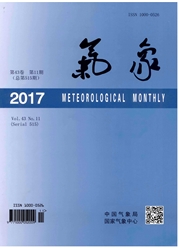

 中文摘要:
中文摘要:
利用NCAR公用陆面模式CLM3(CommunityLandModel3)模拟1979—2003年的土壤蒸发量和植被蒸腾量,分析了中国区域水资源(降水减去地面蒸发和植被蒸散)的气候特征及变化特征。全国水资源分布从东到西、从南到北依次递减,这与全国多年降水分布一致,其中长江以南地区是水资源丰富区,西北地区尤其是新疆地区是水资源匮乏区。从水资源线性变化趋势来看,长江以北大部分地区水资源呈减少趋势,特别是四川盆地和东北地区,变干趋势显著,水资源减少速率为10~15mm/10a;长江以南地区年水资源增加,增加中心在两广地区,水资源增加速率达20~30mm/10a。
 英文摘要:
英文摘要:
On the basis of the CLM3 (Community Land Model .5 ) slmulatecl soil ano canopy evaporation, the climatology and spatial-temporal variations of the land water resource in China are investigated. The distribution of annual mean water resource is similar to that o{ annual mean pre- cipitation in China, with a pattern of the largest in the south of Yangtze River and the smallest in Xinjiang, decreasing gradually from southeast to northwest. The total evaporation shows a close relationship with the precipitation, with the high evaporation region located in south of 35°N and the low evaporation area in north of 35°N, especially in the northwest, where mean annual evaporation may be below 50 mm. From the distribution of evaporation index, we can see a different pattern, in which the high regions are located in northern China and the low regions are in southern China. Analyses of the linear trend show that the land water resource has decreased in most regions of China including northern China north of 35°N except northern Tibetan Plateau, western Xinjiang Autonomy Region and Hetao areas, while increased in the Tibetan Plateau and muthem China during the past twenty years. The decreased (increased) atmospheric precipitable water is generally consistent with the downward (upward) trend of the land water resource and the variation of the precipitable water is considered as an important cause of water resource change.
 同期刊论文项目
同期刊论文项目
 同项目期刊论文
同项目期刊论文
 Spectral dispersion of cloud droplet size distributions and radar threshold reflectivity for drizzle
Spectral dispersion of cloud droplet size distributions and radar threshold reflectivity for drizzle Modeling the time-dependent response of the Asian summer monsoon to obliquity forcing in a coupled G
Modeling the time-dependent response of the Asian summer monsoon to obliquity forcing in a coupled G Timing and origin for sand dunes in the Green River Lowland of Illinois, upper Mississippi River Val
Timing and origin for sand dunes in the Green River Lowland of Illinois, upper Mississippi River Val Diurnal variations of summertime precipitation over the Tibetan Plateau in relation to orographicall
Diurnal variations of summertime precipitation over the Tibetan Plateau in relation to orographicall Evaluating regional cloud-permitting simulations of the WRF model for the Tropical Warm Pool Interna
Evaluating regional cloud-permitting simulations of the WRF model for the Tropical Warm Pool Interna Modeling the climate effects of different subregional uplifts within the Himalaya-Tibetan Plateau on
Modeling the climate effects of different subregional uplifts within the Himalaya-Tibetan Plateau on 期刊信息
期刊信息
